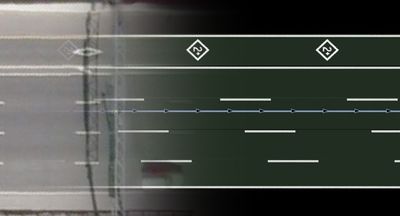Key:hov
 |
| Description |
|---|
| Indicates access for high occupancy vehicles. |
| Group: restrictions |
| Used on these elements |
| Documented values: 1 |
| Useful combination |
|
| See also |
|
| Status: in use |
| Tools for this tag |
|
The hov=* (![]() high-occupancy vehicle lane) tag is used to indicate vehicle occupancy requirements for a way. Access limitations of this type may be known as carpool, diamond, transit, T2, or T3 restrictions depending on the locale.
high-occupancy vehicle lane) tag is used to indicate vehicle occupancy requirements for a way. Access limitations of this type may be known as carpool, diamond, transit, T2, or T3 restrictions depending on the locale.
Values
As with related keys hgv=* and bus=*, hov=* sets OpenStreetMap access permission for all lanes of that way, overriding whatever permissions may exist by default on that way, or have been set higher in the access permission hierarchy. If some lanes on the way are HOV restricted differently (for example, common on carriageways), hov=*, if used, should be supplemented with hov:lanes=* for per-lane access and restrictions.
For all possible values, see access=*. Most commonly used are:
hov=designated: The way is designated to high occupancy vehicles.hov=yes: High occupancy vehicles are allowed. This by itself does not imply that other vehicles are restricted from using the way.hov=no: High occupancy vehicles are not allowed on the way. This by itself does not imply that other vehicle types are allowed to use it.hov=lanehov:lanes=*is the preferred tagging for HOV access restrictions per lane.
Useful addition:
hov:minimum=*: Typical values for this key are2(for "2+" lanes), and3(for "3+" lanes).toll=yestoll:hov=no: For high-occupancy toll (HOT) roads. Usetoll:lanes=*toll:hov=*for the more common case of an HOT lane on an otherwise untolled road.
Lanes
hov:lanes=* is used in cases where some lanes of a way have different HOV requirements from others. Lanes, the article describing tagging individual lanes of a road, fully describes how to do this.
As taken from the Lanes article, specifically regarding HOV lanes, "(hov:lanes=* is) most useful if entrance/egress is permitted at any point along the route; if entering or exiting the HOV lane(s) is only permitted at certain locations, modeling the HOV lane(s) as separate ways is preferable."
That said, here are two examples of how lanes might be tagged.
One driving direction
Without using permission inheritance
highway=motorwaylanes=4oneway=yesmotor_vehicle:lanes=no|yes|yes|yeshov:lanes=designated|yes|yes|yeshov:minimum=2
This is a one way road with four lanes, where the leftmost of the four is designated for 2+ HOV traffic. HOV vehicles are allowed in all four lanes. Note that with highway=motorway, motor_vehicle=yes is almost certainly implied, so we must also restrict regular motor vehicle traffic from the leftmost lane. The motor_vehicle=* restriction, higher in the access restriction tree, is combined with the narrower hov=* allow permission, so '"all" motor vehicle traffic cannot use the leftmost lane, but HOV 2+ traffic is designated for it.'
Using permission inheritance
highway=motorwaylanes=4oneway=yesmotor_vehicle:lanes=no|||hov:lanes=designated|||hov:minimum=2
In this case, we use the fact that highway=motorway has certain default permissions, specifically, motor_vehicle=yes, and hov=yes. We do not have to specifically tag the way with motor_vehicle=yes, nor hov=yes. A lane whose access isn't specified (there is nothing between the two || symbols) will use the defaults, which in both these cases, are yes. The two examples above are functionally identical.
Two driving directions
In the common case of two driving directions either :forward or :backward is added to the end of the key.
oneway=nolanes=6lanes:forward=3hov:lanes:forward=designated|yes|yeshov:lanes:backward=designated|yes|yeshov:minimum=3
This is a road with three lanes per direction. 3+ HOV vehicles are designated on the leftmost lane in each direction. Additional restrictions would have to be added for other vehicle types for these lanes, if necessary.
Please note that the lanes are viewed in the respective driving direction; i.e., hov:lanes:forward=* describes the lanes in the same direction as the osm-way and the first lane-value refers to the leftmost lane in this direction, whereas hov:lanes:backward=* describes the lanes in the opposite direction of the osm-way and the first lane-value refers to the leftmost lane in that direction.
As stated above, please reference Lanes for a complete specification on how to perform HOV access restriction on a per-lane basis.
Editor support
JOSM
HOV lanes can be visualized during editing with the style Land and road attributes using the key hov:lanes=* and a lane-value of designated. The following screenshot shows a motorway tagged with hov:lanes=designated|yes|yes|yes|yes and hov:minimum=2.

Conditional HOV
Where the HOV requirement only applies conditionally, for example just during set times of the day use hov:conditional=* where the HOV applies to all lanes, or hov:lanes:conditional=* where the HOV applies to only some lanes. Syntax should follow Conditional restrictions.